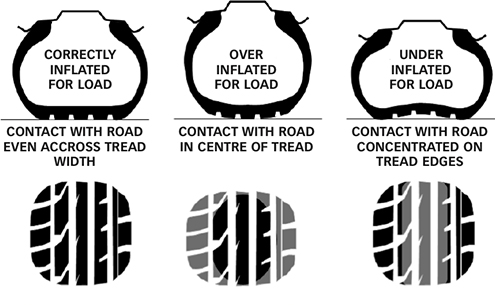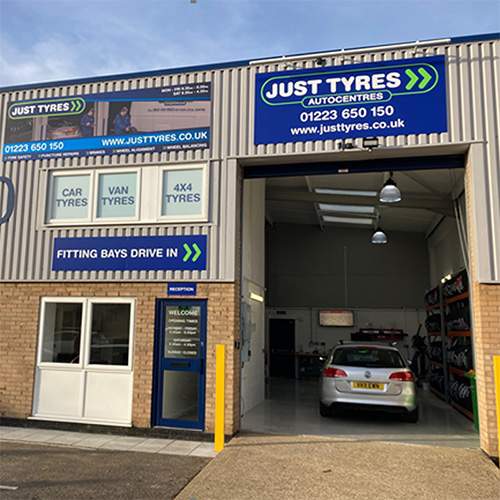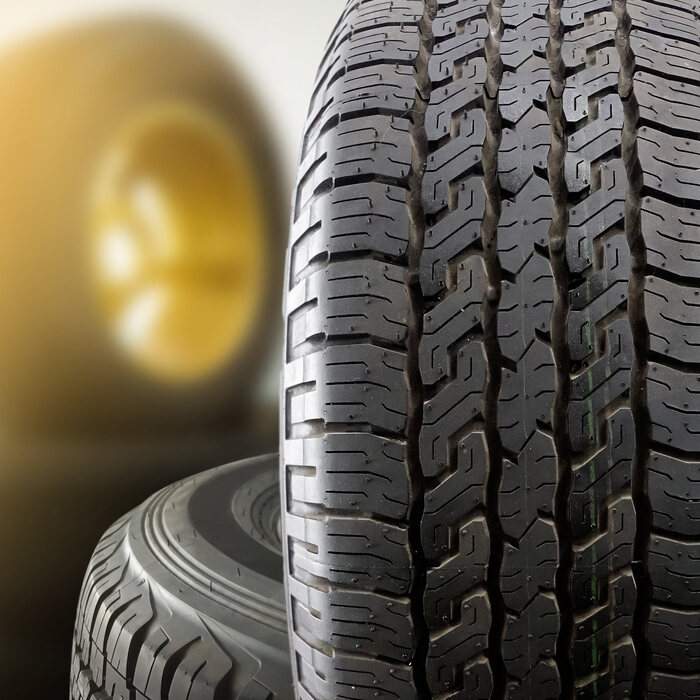HOW TO CHECK TYRE PRESSURE
While different tyres are marketed with various benefits, the efficiency of any tyre is dependent upon maintaining the correct tyre pressure. When the pressure isn’t right, it can have a big impact on how your car handles corners, the braking distance of your vehicle, and how much fuel your car uses.
Fortunately, making sure that your tyres are inflated to the optimum pressure is a quick and easy job. Here’s everything you need to know about checking you tyre pressure
Under-inflation and over-inflation
Firstly, what is tyre pressure? Tyre pressure is a measurement to indicate the amount of air that has been pumped into the inner lining of your tyre, which is measured in pounds per square inch (PSI) or BAR pressure.
When the tyre pressure is either too small or too great, it can lead to under-inflation and over-inflation, which both cause specific problems for your car tyres. As you can see in the diagram below, these differing levels of tyre pressure change how the tyre comes into contact with the road:
Under-inflated tyres are a common problem if you don’t check tyre pressure regularly. When this happens, your tyres will have uneven contact with the road. If left like this for a prolonged period of time, under-inflated tyres will exhibit excess wear on the inside and outside edges of the tread, reducing the tyres’ lifespan.
Low tyre pressure can also lead to increased rolling resistance with the road, which is when more energy is lost as a result of the tyre becoming deformed on the road. More rolling resistance means lower fuel efficiency and higher CO2 emissions!
On the opposite end of the scale, putting too much air in your tyres can be just as damaging too. When tyres are over-inflated, they have a smaller ‘contact patch’, which means less of the tyre is in contact with the road. This leads to a loss of traction, meaning poorer braking distances and decreased handling.
As with under-inflating your tyres, having very high tyre pressure also negatively affects how the tyre wears, with heavy and uneven wear likely to happen across the central part of over-inflated tyres. To avoid these various scenarios, it’s important to inflate your tyres to the right pressure.
Maximum versus optimum tyre pressure
On the sidewall of your tyres you should be able to see the maximum PSI for that particular tyre. This measurement is useful, as it tells you the maximum pressure that your tyre should have to carry its maximum load, which is usually somewhere between 30 and 32 PSI.
As this measurement is a maximum, however, this doesn’t mean you should aim to inflate your tyre to hit this pressure. When tyres are inflated to their maximum PSI, the handling characteristics can change slightly. While this might mean you notice improved cornering, the braking threshold changes because your tyre doesn’t have as much give on the sidewall, making it easier to lose control of the vehicle when braking.
Filling your tyres to the maximum PSI, as with over-inflating tyres, can also lead to quicker wear at the centre of your tyre as well, so what is the optimum tyre pressure to avoid this happening?
All manufacturers provide this information within the car, with the manufacturer’s optimum or recommended tyre pressure listed in your owner’s manual, or on a sticker in the door jam. Some cars may also have these stickers on the fuel flap, or somewhere in the console as well.
Assuming you’ve chosen the right size tyre for your car, following the manufacturer’s guidelines for recommended PSI will help to get the best possible performance from your tyres.
How do I check tyre pressure?
To make sure you are getting the best performance from your tyres, it's important to check them regularly. Ideally, you should try and check either whenever you fuel up your car, if there is a big change in temperature, or every 30 days. Tyres can leak air over time, so checking at least once a month or before a long journey is a good idea!
Fortunately, it’s easy to check your tyre pressure, and this can be done at any petrol station using the self-service air pressure pumps on the forecourt.
To check your tyre pressure, start by finding the optimum or recommended tyre pressure in your owner’s manual, or on a manufacturer’s sticker in your car. Once you’ve found this information, you need to check the current pressure in each of your tyres.
Remove the cap from the tyre valve and push the air pump into it. On the air pressure pump, you should now see a gauge window, which shows the current pressure of that tyre. If the tyre pressure is lower than the recommended PSI, then you can inflate the tyre by squeezing the air trigger in short bursts. Continue to do this until the pressure on the gauge reaches the optimum PSI level.
If your tyre pressure is too high, you can also deflate the tyre by pulling the pump valve away slightly from the tyre valve. Again, you should do this in short bursts until you reach the correct PSI. You should hear a hissing noise as the air escapes.
Once you have the right tyre pressure, put the cap back on your tyre valve and move on to the next tyre. Remember to check all of your tyres - including the spare if you have one - as depending on the differing loads your car carries (such as number of passengers), each of your tyres may lose pressure unevenly.
Making sure you have the optimum tyre pressure is quick and easy, and helps to increase the performance and lifespan of your tyres, improve fuel efficiency and CO2 emissions, and makes you car safer and easier to drive.






 Same Day Fitting. Order By 10:30am
Same Day Fitting. Order By 10:30am
 39 Nationwide Fitting Centres
39 Nationwide Fitting Centres
 5 Year Warranty On All Tyres
5 Year Warranty On All Tyres
 Price Check Promise. Always Great Deals
Price Check Promise. Always Great Deals

 Find a Centre
Find a Centre

